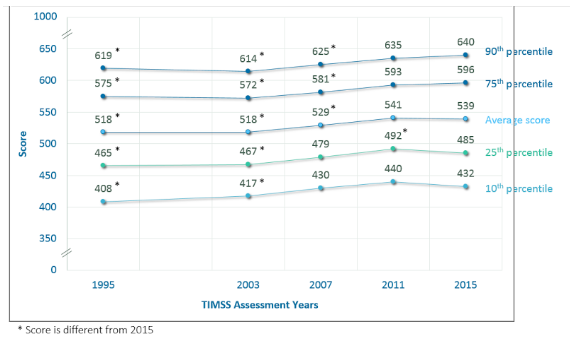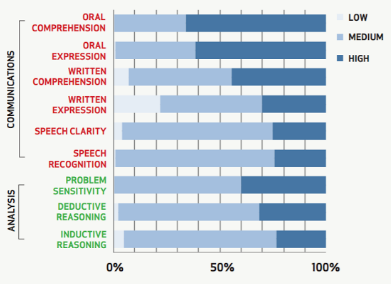Why Does Math Anxiety Continue to Plague Americans?


Like so many math educators across the country, my goal has always been to help students learn to love mathematics.
If they can’t love math, I hope to instill in them an anxiety-free appreciation for the subject. However, mathematics has the unlucky designation of the most-feared school subject, with American math teachers fighting to assuage pervasive math anxiety and change their students’ minds about math.
The deeply negative feelings that many Americans hold for the subject of mathematics continues to shape education research and classroom pedagogy. Stanford University mathematics professor, Jo Boaler, recently published the second edition of her book What’s Math Got To Do With It (2015), in which she emphasizes the need for math students to have a growth mindset.
“One of the most damaging mathematics myths propagated in classrooms and homes is that mathematics is a gift — that some people are naturally good at math and some are not.” (Boaler, pg. xvii)
Educators have known for decades that mathematical ability is not a hereditary trait. So why do math students in American classrooms still struggle with immense levels of anxiety and fear?
Last month, the Trends in International Mathematics and Science Study (TIMSS) results were released for the year 2015. These results spurred headlines lamenting US students’ test scores lagging behind places like Russia and East Asia. And while the United States happily ranked in the top 20 countries in the study (and scored above the centre point in both 4th and 8th grade assessments), its achievement hasn’t improved since before 2011.

According to the TIMSS, US mathematics scores have improved at both the 4th and 8th grade benchmarks over a 20 year trend line. However, the top-performers (Singapore, Hong Kong SAR, Korea, Chinese Taipei, and Japan among them) continue to maintain their 20-year edge over the United States. These countries are outscoring the US by significant margins: 4th graders in Singapore score at an advanced level nearly four times as often as American 4th graders!

Another international student assessment, known as the PISA (Program for International Student Assessment), released its results last week. The US results were similarly disappointing. According to the PISA, US students’ mathematics scores have actually declined overall. While this decline has also happened in other countries (including some of the top performers), the US sits in a disheartening position: 42nd out of 70 participating countries.
While it’s hard to quantify the impact that America’s unique phobia of math has on our national rankings, its implications for our children’s future career opportunities are irrefutable.
If we can’t find a way to alleviate their fear and reluctance toward mathematics, we won’t be able to prepare them for the STEM-focused jobs of the future. Further, they won’t learn the crucial skills of problem-solving, deductive reasoning, and critical thinking that a whole and immersive math education provides. In fact, according to a Georgetown research paper, STEM jobs are one of the of the fastest-growing occupations, and 70% of all occupations require significant mathematical knowledge for success.

So what can we do, as parents, teachers, and educators, to change our students’ minds about math?
- Remove the risk! Mathematics is a tool to solve problems, and as such, it’s actually helpful and necessary. Students should be no more afraid of Math than they are of English! Mistakes should be treated as an important and necessary part of the problem-solving process, not as evidence of failure or a loss of progress.
- Help students see and appreciate math around them. Do they love sports? Ask them why shooting percentage helps coaches identify their best players. Are they glued to their phones all the time? See if they can guess how many texts they send a day, and ask if they can calculate how many that means they could send in a whole year.
- Maintain a growth mindset. Talk to students about their goals, and ask them about the kinds of things they’ll do to get there. Share your own ambitions, and speak about those ambitions confidently. Help students see that. After all, it’s practice and perseverance (not innate talent) that will develop those skills. From shooting free throws to dividing fractions, anyone can learn to be great at anything. Mistakes (or missed baskets) are just part of getting there.
CITATIONS:
Boaler, J. (2015). What’s Math Got To Do With It? New York, NY: Penguin Books.
Burns, M. (1998). Math: Facing an American Phobia. Sausalito, CA: Math Solutions Publications.
Infographic: Mathematics Achievement — Fourth Grade. Retrieved December 14, 2016 from http://timss2015.org/timss-2015/mathematics/student-achievement/
Infographic: Intensities of Abilities Uses’ Across All Occupations. Retrieved December 06, 2016 from https://cew.georgetown.edu/wp-content/uploads/2014/11/Recovery2020.ES_.Web_.pdf
Program for International Student Assessment (PISA) 2015. Retrieved December 14, 2016 from http://nces.ed.gov/surveys/pisa/
TIMSS. Retrieved December 8, 2016, from http://timss2015.org/timss-2015/mathematics/student-achievement/
PISA Results. Retrieved December 14, 2016, from http://nces.ed.gov/surveys/pisa/pisa2015/pisa2015highlights_6a.asp

